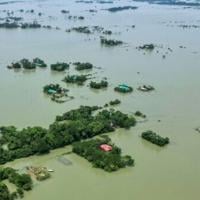Six individuals lost their lives in floods caused by heavy rains in northeast India and nearby Bangladesh, resulting in over a million homes being submerged, officials confirmed on Wednesday. Monsoon rains lead to significant damage each year, with experts attributing the increase in extreme weather events to climate change.
Authorities in Assam, a northeastern state in India, reported four recent casualties, bringing the total number of deaths since mid-May to 38 due to continuous rainfall. In Bangladesh, two individuals, including a Rohingya refugee, were killed in landslides caused by intense monsoon rains early Wednesday morning.
Government official Abu Ahmed Siddique reported the most severe flooding in northeastern Sylhet division, affecting more than 1.3 million people. He stated that their villages and homes have been submerged by floodwaters.
Kamrul Hasan, secretary of Bangladesh’s disaster management ministry, highlighted the rising water levels in rivers due to upstream rain in India. The Ganges and Brahmaputra rivers flow through low-lying Bangladesh, leading to flooding in the region.
The Indian weather department has issued warnings for Assam and other neighboring states, alerting residents of potential flash floods. The Kaziranga national park, home to a significant number of one-horned rhinos, has also been flooded, forcing animals to seek higher ground.
The summer monsoon season accounts for a majority of South Asia’s annual rainfall but also brings death and destruction through flooding and landslides. Scientists attribute the increased severity and unpredictability of the monsoon to climate change.
Recent tragedies caused by monsoon-related disasters include fatalities in Nepal, Bangladesh, and Sikkim, demonstrating the devastating impact of extreme weather events in the region.
str-sa-ash/gle-fox





